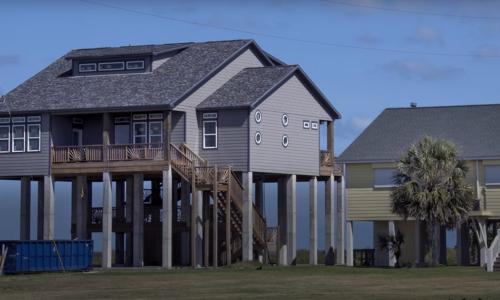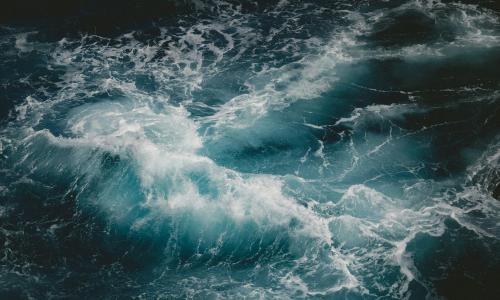Looking out over the vast marshy wetlands that stood between them and the Manhattan skyline shimmering in the background, Hugh Carola and Michele Langa of the conservation society Hackensack Riverkeeper called the Meadowlands the salvation for several cities and towns in New Jersey during 2012’s Hurricane Sandy.
For more information, see the accompanying report: "When Rising Seas Hit Home (2017)"
“A buffer that literally means life and death”
On a driving tour to various shoreline spots, Langa, an attorney for the group, pointed back to two homes that still showed subtle water stains from the crest of Sandy's floodwaters. “This is where the marsh saved this area," she said. "The violence of Sandy’s water was absorbed by the marsh and rose slowly against the houses. If they had been hit by the same surge as the outer boroughs of New York and the Jersey Shore, they would have been gone."
More important, according to The New York Times’s interactive mapping of the death toll, only one person died in the Hackensack River region—a 69-year-old man who reportedly stumbled and drowned after leaving his inundated car—compared to the clusters of fatalities along shorelines.
“It could have been so much worse,” said Carola, the Riverkeeper’s program director. “The wetlands are a buffer that literally means life and death.”
A new challenge dawns
It is obvious what has to be done to continue to protect this area: preserve the 7,000 acres of wetlands that remain of the 21,000 acres the region had before World War II and the 14,000 acres it had as late as the 1990s. Most people know the area for the giant Meadowlands stadium complex, which plays host to the New York Giants and New York Jets professional football teams; the adjacent wetlands are a powerhouse of different sort.
The preservation efforts of groups such as Hackensack Riverkeeper have kept the remaining marsh off-limits to development, with many benefits. Despite high levels of mercury and other heavy metals left behind by industrial activity that have some advocates wanting the area declared a Superfund site, the clean up efforts to date have allowed a rich array of wildlife to return to the watershed. One bald eagle pair recently fledged three chicks. Owls and osprey hunt, butterflies flutter, and a rare calliope hummingbird was spotted and photographed in a yard in Secaucus.
To emphasize his point, Carola drove to a boat dock where there was a flock of black skimmers, a tern-like black and white bird with a striking red and black beak. It is listed as endangered in New Jersey. "Last year we had thousands of people kayaking and riding pontoons and had 1,000 people participating in river cleanups, from pre-K to senior citizens,” Carola said. “We had garden clubs, church groups, school groups. We think people are getting the message that the flowing waters of our nation belong to everybody.”
That message is getting through just as a new challenge dawns on the region in the form of rising seas caused by climate change. The area has begun to experience more flooding at the highest tides. “I talk to senior citizens a lot and they tell me about times that streams rose slowly during rains,” Carola said. “Now, rains bring them right up to flood stage.”
Many of the bigger and more financially stable businesses are back, some raising their foundations three feet and generators six feet. But several mom-and-pop operations closed for good, highlighting a common theme when disaster strikes: those with the least resources to cope get hit the hardest.
On the driving tour, Lopez pointed out the site of an apparel company owned by immigrants. Their boxes of clothes had been stored outside at ground level, and the company was ruined during Sandy, when there wasn’t enough room or time to get them inside.
Lopez said he notices on an anecdotal level that water lingers longer in the streets after heavy rains. A new tidal gate was christened in 2014, but Lopez said it takes more than a gate to hold back the water. He drove to a location where the backyard of several businesses is the marsh.
"One concern of mine is with the water getting higher, it makes it more important to stop illegal dumping in our marshes and waterways," he said. "The debris clogs the drains and makes the water build up."
Because of Sandy, the federal government awarded the Meadowlands area a $150 million grant to devise plans to reduce the risk of floods and improve storm-water drainage. There are several proposals currently being debated, including one to attempt to wall out the water. Groups such as Hackensack Riverkeeper are lobbying for solutions that focus on making the wetlands more resilient than resistant by improving the drainage ability of the wetlands and increasing open space and green infrastructure.
While the region’s uniformly low elevation presents a major long-term challenge in the face of sea level rise, having more open space could be critical to the future health of the wetlands. Wetlands that have the space to migrate may keep pace with sea level rise rather than be drowned by rising waters.
“We’re totally focused on natural ways to deal with the future,” Carola. “It was nature that saved us from the worst effects of Sandy.”




